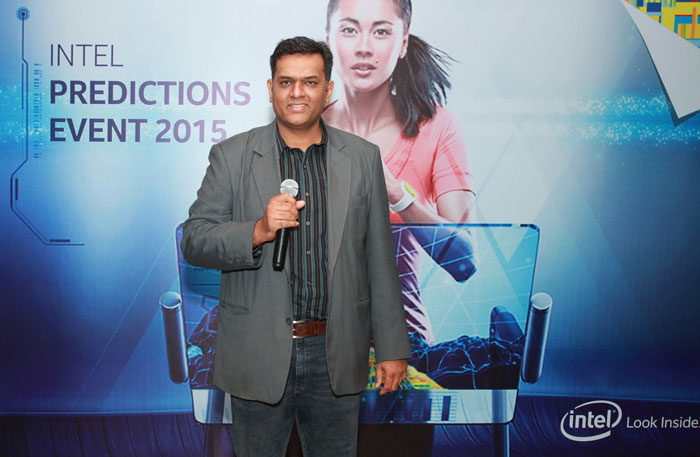Intel is powering all the world of computing and now it offers Bangladesh too. 2014 was an exciting year for Intel in the Asia Pacific and Japan region and Intel made smarter, faster and more secure computing through revolutionary technology through the year. The rapid pace of innovation we’ve seen across all IT will continue into 2015 to usher in the Era of Integration
Intel held the ‘INTEL PREDICTIONS EVENT 2015’ on December 17, 2014, Wednesday in Dhaka. The Predictions Event recapped key moments from 2014 and a look ahead at predictions for the coming year.
Zia Manzur, Country Business Manager for Intel in Bangladesh resented a keynote speech highlighting it has been another breakthrough year for Intel and the IT industry as a whole, with the Asia Pacific and Japan region being a major driver for significant change. With advancements in technology across all IT– from mobile devices and Internet of Things (IoT) to backend IT infrastructures– the rapid pace of innovation will continue into 2015. Intel is ushering in the age of integration, a time when technology and computational power will no longer be an adjunct to our daily lives, but an integral, immersive and all-encompassing part.
Kicking off 2014 at CES, Intel CEO Brian Krzanich challenged the company to have its chips in 40 million tablets in 2014– an increase of 30 million compared to 2013. Intel had shipped more than 30 million tablets by Q3’14, was tracking more than 250 tablet designs in over 150 countries, and was ranked by Strategy Analytics as the number two application processor vendor for tablets.
Intel continued to deliver benefits of the Moore’s Law through its investments in leading-edge capacity, making higher performance, more energy-efficient, denser and cost-effective solutions available to an ever-broader set of market segments. This resulted in delivering the world’s first 14nm technology in volume production ahead of the competition. Intel’s 14nm technology will be used to manufacture a wide range of high-performance to low-power products including servers, personal computing devices and IoT.
Innovating in chips across all mobile form factors, Intel delivered enhanced performance, battery life and features, as well as lightweight designs for a range of mobile form factors that includes PCs, laptops, Ultrabooks, 2 in 1s and tablets, including the first systems based on the new Intel® Core™ M processors.
At the same time, devices powered by Intel® Atom™ processor Z3000 series (code-named Bay Trail) were launched, delivering fast and fluid experiences in a mobile environment on both Windows 8 and Android. Intel also announced the commercial availability of its second generation LTE platform, the Intel® XMM™ 7260 LTE-Advanced modem with Samsung Galaxy Alpha premium smartphone shipping with it. The Intel® XMM™ 7262LTE-Advanced modem was also certified on China Mobile, China’s largest operator, which provides more opportunities to work with one of the most exciting LTE subscriber markets in the world.
To help companies from all industries turn data into actionable insights, Intel launched its Intel® Xeon® processor E7 v2 and Intel® Xeon® processor E5-2600/1600 v3 product families. It also announced that 81 per cent of the world’s TOP 500 supercomputers use Intel processors.
Beyond technology itself, Intel believes that young people are the key to innovation, and this year at The Intel International Science and Engineering Fair– the world’s largest high school science research competition –15 year old Nathan Han won top prize for his machine learning software tool studying mutations of a gene linked to breast cancer. Demonstrating that APJ is a hub of innovation, fifty-one students from across the Asia Pacific and Japan region were recognized with awards this year for their designs.
Further equipping tomorrow’s leaders with devices enriching their learning experiences, Intel introduced the next generation Intel Education Tablet and Intel classmate PC reference designs. Both are student friendly, rugged designs that can with stand incidents like falling from a desk, and provide water and dust resistance to promote anywhere, anytime learning.
Across the world, including Asia Pacific and Japan, Intel is driving to narrow the digital divide and gender gap in technology, through programs such as the Intel® Learn Program and the Intel® Computer Clubhouse Network (ICCN), where girls gain the skills to become the next generation of leaders. Additionally, over the past 12 years, Intel has trained more than 10 million teachers, including an estimated 5 million female teachers in 70 countries.
Alongside this year’s plethora of technical innovations, Intel also demonstrated its commitment to enriching the lives of people all over the world with technology. In pursuit of a conflict free world, Intel announced that it is working to eliminate all conflict minerals from its supply chain – a positive move influencing the entire manufacturing process. For the seventh-year in a row Intel was also named the largest voluntary purchaser of green power in the U.S.

